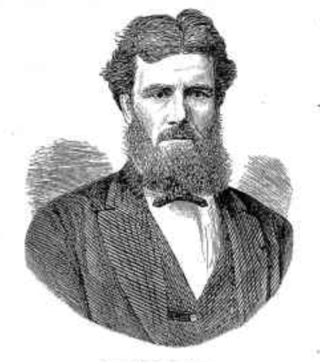
Sir Charles Cowper, was an Australian politician and the Premier of New South Wales on five occasions from 1856 to 1870.

Sir John Robertson, was a London-born Australian politician and Premier of New South Wales on five occasions. Robertson is best remembered for land reform and in particular the Robertson Land Acts of 1861, which sought to open up the selection of Crown land and break the monopoly of the squatters.

The Hon. William Munnings Arnold was an Australian politician, a member of the New South Wales Legislative Assembly from 1856 until his death. He held numerous ministerial positions between 1860 and 1865 including Secretary for Public Works] and Secretary for Lands. He was the Speaker between 1865 and 1875.

Edward Flood was an Australian politician. He was a member of the New South Wales Legislative Council between 1851 and 1856 and again from 1879 until his death. He was also a member of the New South Wales Legislative Assembly between 1856 and 1872. He was the first Secretary for Public Works in New South Wales.
The first Cowper ministry was the second ministry of the Colony of New South Wales, and was led by Charles Cowper. It was the first of five occasions that Cowper was Leader of the Government. Cowper was elected in the first free elections for the New South Wales Legislative Assembly held in March 1856, and fought unsuccessfully with Stuart Donaldson to form Government. When Donaldson's Government faltered a little over two months after it was formed, Cowper formed Government.
The third Cowper ministry was the seventh ministry of the Colony of New South Wales, and third occasion of being led by Charles Cowper.
The fourth Cowper ministry was the ninth ministry of the Colony of New South Wales, and fourth occasion of being led by Charles Cowper.
The fifth Cowper ministry was the twelfth ministry of the Colony of New South Wales, and the fifth and final occasion of being led by Sir Charles Cowper.

Sir Saul Samuel, 1st Baronet was an Australian colonial merchant, member of parliament, pastoralist, and prominent Jew. Samuel achieved many breakthroughs for Jews in the colonial community of New South Wales including the first Jew to become a magistrate, the first Jew elected to parliament, the first Jew to become a minister of the Crown.
The fifth Robertson ministry was the 22nd ministry of the Colony of New South Wales, and was led by the Premier, Sir John Robertson. It was the fifth and final occasion that Robertson was Premier. Robertson was elected in the first free elections for the New South Wales Legislative Assembly held in March 1856.

The Wade ministry was the 33rd ministry of the New South Wales Government, and was led by the 17th Premier, Charles Wade. The title of Premier was widely used to refer to the Leader of Government, but was not a formal position in the government until 1920. Instead the Premier was appointed to another portfolio and Wade chose to keep the portfolio of Attorney General he held in the Carruthers ministry.

The Chief Secretary of New South Wales, known from 1821 to 1959 as the Colonial Secretary, was a key political office in state administration in New South Wales, and from 1901, a state in the Commonwealth of Australia. During much of the 19th century, the Colonial Secretary was the pre-eminent figure in public life. The role of the Chief Secretary changed significantly from the time of its creation in 1821 to its final use in 1995, with various responsibilities changing hands. Nominally subordinate to the Governor of New South Wales from the early 19th century until the beginning of full self-government in 1856, he was effectively a government record-keeper and the officer with responsibility for the general administration of the colony. However, for most of its history the Chief Secretary was in charge of all matters relating to correspondence with government departments, naturalisation, the Great Seal, state security, censorship and classification laws, the arts, Public Health, Aboriginal welfare, Lord Howe Island, and environmental protection and fisheries.

The Postmaster-General of New South Wales was a position in the government of the colony of New South Wales. This portfolio managed the postal department of the New South Wales Government and was in charge of all postal and communications services in the colony prior to the Federation of Australia, from 1835 to 1901. Upon Federation, Section 51(v) of the Constitution of Australia gave the Commonwealth exclusive power for "postal, telegraphic, telephonic, and other like services".

The Cahill ministry (1959) or Fourth Cahill ministry was the 58th ministry of the New South Wales Government, and was led by the 29th Premier, Joe Cahill, of the Labor Party. The ministry was the fourth and final of four consecutive occasions when the Government was led by Cahill, as Premier.

James Hoskins was a politician in colonial New South Wales.

Sir John Lackey was a magistrate and politician in colonial New South Wales, President of the New South Wales Legislative Council 1892 to 1903.

The Minister for Youth Justice, formerly Minister for Justice, is a ministry in the administration of New South Wales. The position supports the Attorney General and was sometimes, although not always, held concurrently with that office.

The Minister for Lands and Property, also called the Secretary for Lands was responsible for one of the key issues for the colonial administration of New South Wales, being the contest between squatters and selectors to dispossess the Aboriginal people of their land.

The Secretary for Mines was a ministry first established in 1874 in the first ministry of Henry Parkes. It went through various title changes, becoming the Minister for Mines in 1959 then variations on Minister for Mineral Resources .

The Secretary for Lands and Works was one of the first ministries in the colonial administration of New South Wales following the establishment of responsible government in 1856.











